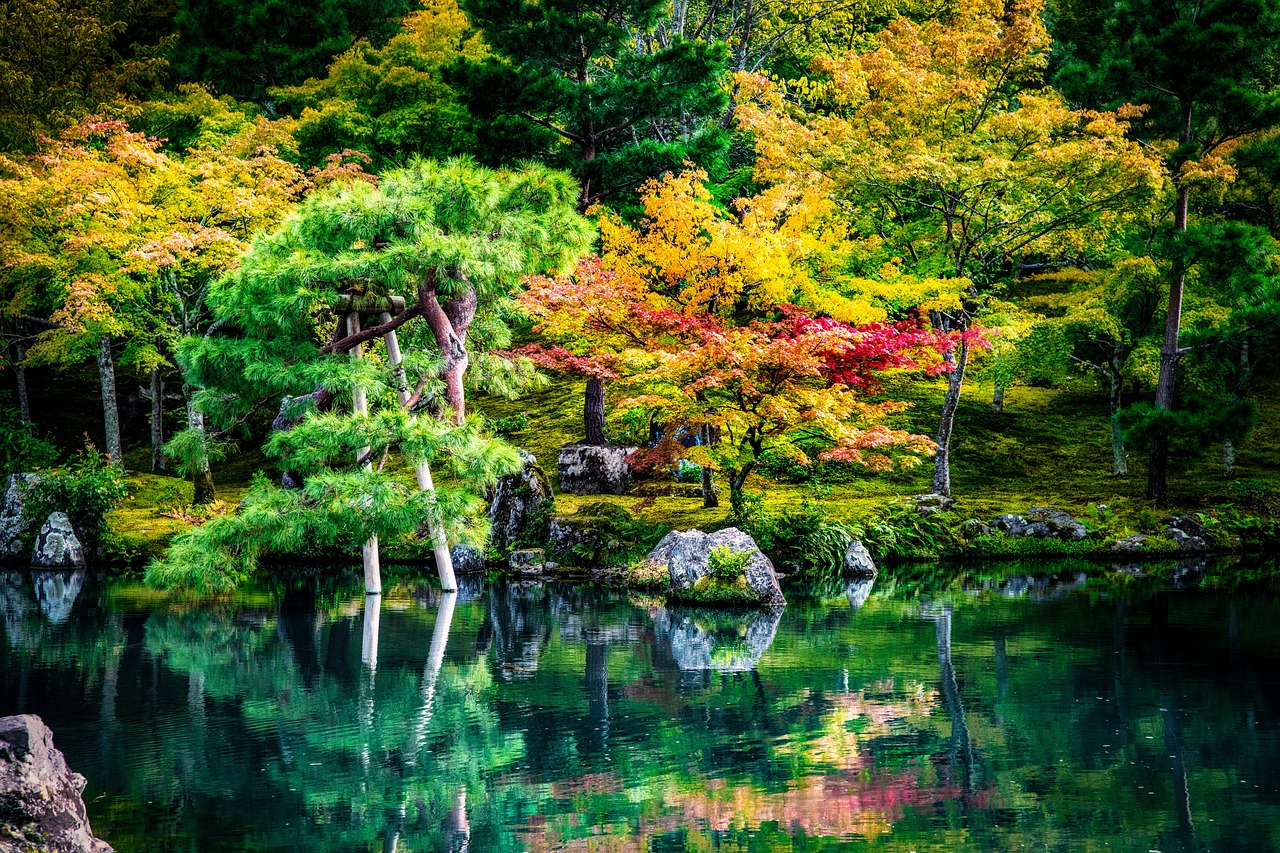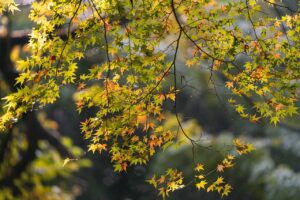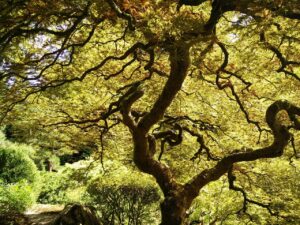Japanese Maple
Overview
The Japanese maple, or *Acer palmatum*, is celebrated for its stunning foliage and graceful shape, making it a prized feature in gardens. These versatile trees, which can vary from petite shrubs to towering 25-foot specimens, flourish in cool, dappled sunlight and enjoy well-drained soil2 3. Coveted for their ornamental value, their leaves paint the landscape in hues of green, yellow, and burgundy, especially vivid in autumn. Issuing a serene presence, they embody a touch of traditional Japanese aesthetics with minimal maintenance1 4.

Characteristics
Known for its stunning foliage, graceful growth habit, and vibrant autumn colors.
Region
East Asia, particularly Japan, China, and Korea.
Natural Habitat
Japanese maple plants are typically found in understory regions of forests.
Cultivation
Prefers cool, light shade; requires regular watering; thrives in well-draining, slightly acidic soil.
Uses and Benefits
The Japanese maple (Acer palmatum) is a treasured plant that offers more than just visual appeal. Its leaves, bark, and even seeds have been used for various purposes, making it a versatile addition to any garden.
The young leaves of the Japanese maple are edible and can be consumed either raw or cooked. These tender leaves add a unique flavor to salads, imparting a slightly bitter taste that complements other greens. In some regions, the leaves are also used to wrap rice cakes or other traditional dishes, infusing them with a subtle maple aroma.
The bark of the Japanese maple has been used in traditional medicine for its potential health benefits. It contains several compounds, such as tannins and flavonoids, which have been studied for their antioxidant and anti-inflammatory properties1. Some herbalists recommend using Japanese maple bark to help alleviate digestive issues, skin irritations, and other ailments, although more research is needed to confirm its efficacy.
The seeds of the Japanese maple, known as “samara,” are not only decorative but also have practical uses. These small, winged seeds can be roasted and consumed as a snack, offering a nutty flavor and crunchy texture. In some cultures, the seeds are ground into a powder and used as a natural sweetener or flavoring agent in various dishes.
Beyond its culinary and medicinal uses, the Japanese maple is an excellent choice for:
- Bonsai: Its small leaves and adaptable growth habit make it a favorite among bonsai enthusiasts.
- Erosion control: The dense, fibrous root system helps stabilize soil and prevent erosion on slopes or hillsides.
- Wildlife habitat: The delicate branches and foliage provide shelter and nesting sites for small birds and insects.
In conclusion, the Japanese maple is not only a visually stunning plant but also offers a range of uses and benefits. From its edible leaves and medicinal bark to its practical applications in landscaping and wildlife habitats, this versatile tree is a valuable addition to any garden.

Cultivation Tips
To help your Japanese maple thrive and showcase its stunning foliage, follow these cultivation tips. Choose a cool, lightly shaded location with well-draining soil. Enhance the soil by mixing in sand and perlite or vermiculite to create optimal growing conditions2. When planting, dig a hole as deep as the pot and water generously before and after placing the tree in its new home. Apply a layer of mulch around the base to help retain moisture4.
To keep your Japanese maple healthy and vibrant:
- Water regularly to maintain consistent soil moisture
- Apply fertilizer around the drip line to nourish the tree as it grows5
- Avoid excessive pruning, allowing the tree’s natural shape to shine
With minimal intervention and these simple care techniques, your Japanese maple will captivate onlookers with its enchanting beauty for years to come4.
Seasonal Considerations
To ensure your Japanese maple thrives throughout the seasons, consider the following tips:
- In spring, apply a slow-release, balanced fertilizer around the drip line to support new growth and foliage development. Water regularly to maintain consistently moist soil, especially during dry spells.
- During summer, provide shade to protect the delicate leaves from scorching sun. Mulch around the base to retain moisture and regulate soil temperature. Monitor for signs of heat stress, such as wilting or curling leaves, and increase watering frequency if needed.
- As autumn arrives, enjoy the breathtaking display of vibrant colors. Reduce watering frequency as the tree enters dormancy, but ensure the soil doesn’t completely dry out. Remove fallen leaves to prevent fungal growth and maintain good air circulation.
- In winter, protect your Japanese maple from harsh winds and freezing temperatures by wrapping the trunk and branches with burlap or applying anti-desiccant sprays. Avoid pruning during this time, as it can stimulate new growth that may be damaged by cold weather.
By adapting your care routine to the changing seasons, you’ll create the ideal environment for your Japanese maple to showcase its stunning foliage year-round2.

Issues and Troubleshooting
While Japanese maples are known for their resilience, they can encounter a few issues that are important to watch out for. One common problem is leaf scorch, which manifests as browning edges on the delicate leaves. This tends to occur in areas with hot, dry winds or when the tree is planted in an overly sunny spot4.
Another issue to be aware of is root rot, which can arise if the soil is too wet or has poor drainage. This serious condition can damage or even kill your Japanese maple tree2. To prevent this, ensure your tree is planted in well-draining soil and avoid overwatering.
Pests can also trouble your Japanese maple from time to time. Common culprits include:
- Aphids
- Scale insects
If you notice a sticky residue on the leaves or branches, it could be a sign of these pests1.
The good news is that with proper care and monitoring, these issues can usually be managed effectively. Here are some tips:
- Plant your Japanese maple in a spot with partial shade to avoid leaf scorch
- Ensure the soil has good drainage to prevent root rot
- Regularly inspect your tree for signs of pests and treat promptly if needed
By staying vigilant and providing your Japanese maple with the care it needs, you can keep it healthy and beautiful for years to come.
History and Folklore
The Japanese maple (Acer palmatum) is a beloved emblem of Japan’s affinity with nature, steeped in history and brimming with folklore. Native to the lands of East Asia, including Japan, China, and Korea, this tree whispers tales from its indigenous roots.
For centuries, the Japanese maple has been a staple in traditional Japanese gardens, reflecting a deep horticultural admiration and a fusion of art and nature. Every leaf and branch of these maples holds a purpose and tells a story, capturing a philosophy that has been cherished for generations2.
The sinuous shapes and vibrant leaves of the Japanese maple have long inspired artists and poets alike. Its presence has fueled the cultural imagination and embodied the seasonal rhythms of its native landscapes. From the delicate pinks of spring to the fiery reds of autumn, the colors that dance upon the leaves of this tree have captivated hearts and minds for centuries.
Truly, the Japanese maple is a horticultural treasure, with a folklore as rich and diverse as the hues that adorn its leaves with each turning of the seasons. Its legacy is a testament to the deep connection between nature and culture that has long defined the lands of East Asia.
References
1. How to Grow and Care for Japanese Maple Trees – The Spruce, https://www.thespruce.com/japanese-maple-growing-profile-3269337
2. How to Grow and Care for Japanese Maple Trees – Gardener’s Path, https://gardenerspath.com/plants/landscape-trees/japanese-maple/
3. How to Successfully Grow Japanese Maples: A Field Guide to Planting …, https://www.gardenista.com/garden-design-101/trees/japanese-maple-tree-acer-palmatum/
4. How to grow Japanese maples / RHS Gardening, https://www.rhs.org.uk/plants/acer/japanese-maples/growing-guide
5. How to Plant Japanese Maple Trees | Planting & Care Guide for Japanese …, https://www.thetreecenter.com/guides/plant-japanese-maples/
Image Credit: GPoulsen
Image Credit: Kanenori
Image Credit: WTM-Consulting
Nicolas Duval
Nicolas is a passionate advocate for nature and the art of wildcrafting. His dedication shines through in Wildcraftia, a website he meticulously crafted to serve as a haven for nature enthusiasts worldwide. Driven by a deep appreciation for nature’s connection to humanity, Nicolas embarked on his journey in 2011 with SmokableHerbs, a platform showcasing his love for nature’s bounty. Building upon this foundation, he established Smokably, a thriving online store offering premium herbs and blends to a global audience.
